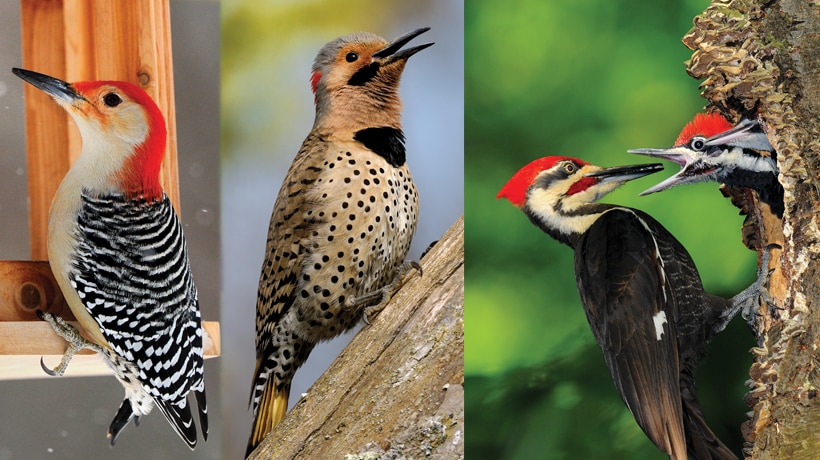Coming Across Woodpeckers in Florida: Variety Variety and Recognition
Discover the Fascinating Globe of Woodpeckers: Everything You Required to Know
The globe of woodpeckers is a realm loaded with unique actions, complex adaptations, and a varied variety of types. From their habitats and distribution patterns to their feeding behaviors and specialized anatomical features, woodpeckers have actually long mesmerized the interest of ornithologists and nature lovers alike. Recognizing the complexities of these remarkable birds gives a peek right into the complicated interplay in between their biology and the atmosphere. As we check out the world of woodpeckers additionally, we uncover a wide range of info that drops light on their importance in ecosystems and the difficulties they face in an ever-changing world.
Woodpecker Habitats and Circulation
Woodpeckers inhabit a diverse series of atmospheres worldwide, showcasing flexibility in their distribution patterns. These resilient birds are discovered in forests, forests, savannas, and deserts throughout numerous continents, showing their capacity to thrive in different climatic conditions. In North America, for example, woodpeckers can be found in both coniferous and deciduous forests, utilizing their strong beaks to forage for insects and create nesting cavities in trees. In Africa, certain woodpecker types have actually adapted to arid atmospheres, such as the acacia forests, where they play a vital function in managing insect populaces.

Feeding Behaviors and Diet Regimen
Among the various elements of their habits, woodpeckers display unique feeding routines and dietary preferences. These birds are mainly insectivores, with a diet plan that includes ants, beetles, caterpillars, and other insects found in trees. Woodpeckers use their solid beaks to pierce into the bark of trees, probing for insects and larvae hidden below the surface. Along with pests, woodpeckers additionally eat nuts, seeds, fruits, and sap. Some varieties have actually specialized tongues with barbed pointers that assist them draw out bugs from crevices in wood.
Woodpeckers are known for their drumming behavior, which offers not just to interact with other woodpeckers but additionally to situate food. The quick drumming noise is produced by the bird pecking on resonant surface areas like dead trees or steel poles. This actions can draw in bugs hidden in the wood, permitting the woodpecker to identify their existence and feed upon them.
Unique Adjustments for Tree Climbing
In their skilled search of pests hidden within tree bark, woodpeckers have progressed impressive physiological features that equip them with distinct adaptations for effective tree climbing. Woodpeckers have strong neck muscles and an unique skull framework that soak up the influence of constant pecking, allowing them to climb vertically without causing harm to their brains. These adaptations display the incredible evolutionary layout that enables woodpeckers to browse trees with precision and performance.
Diverse Woodpecker Variety Worldwide
With over 200 different species spread out across different habitats worldwide, the family of Picidae encompasses an amazing diversity of woodpeckers. These birds can be discovered in woodlands, forests, savannas, and even urban locations, showcasing their flexibility to various atmospheres. From the famous Northern Flicker in The United States And Canada to the vibrant and elusive Crimson-backed Flameback in Asia, each woodpecker varieties shows special qualities in terms of quill, behavior, and environment choice.
Woodpeckers vary greatly in dimension, with the small Downy Woodpecker measuring around 6-7 inches in length, while the powerful Lineated Woodpecker can reach up to 17 inches - Woodpeckers in Florida. Their beaks additionally are available in different forms and dimensions, reflecting their feeding routines. Some types specialize in click for info removing bugs from tree bark, like the Acorn Woodpecker, while others, such as the Black-cheeked Woodpecker, feed upon fruits and seeds

Preservation Efforts and Challenges
Conservation initiatives for woodpecker populations are vital in minimizing the influence of habitat loss and other dangers encountering these varied bird varieties. Woodpeckers face various challenges to their survival, largely due to deforestation, urbanization, climate change, and invasive species. To address these issues, conservation efforts concentrate on protecting and bring back woodpecker habitats, carrying out sustainable forestry methods, and elevating awareness regarding the value of these birds in environments.
One considerable difficulty in woodpecker conservation is the useful site fragmentation of their habitats, bring about isolated populations that are more vulnerable to termination - Woodpeckers in Florida. Preservationists function to produce wildlife corridors and protected locations that link these fragmented habitats, allowing woodpeckers to relocate between different areas for feeding, breeding, and sanctuary

Conclusion
In conclusion, woodpeckers are interesting birds with unique adjustments for tree climbing and feeding habits. They directory can be located in varied environments worldwide, encountering preservation obstacles as a result of environment loss and human tasks. Understanding their habitats, diets, and behaviors is important for preservation efforts to safeguard these essential bird types. Additional research study and conservation actions are needed to ensure the survival of woodpeckers in the wild.